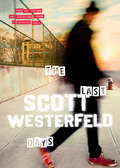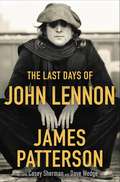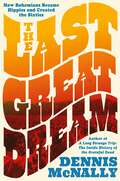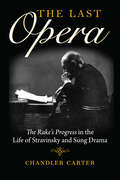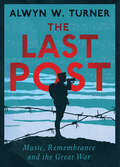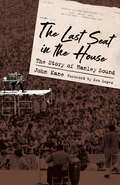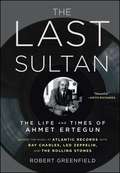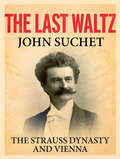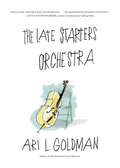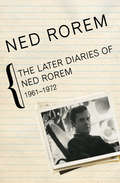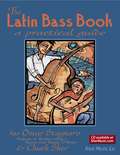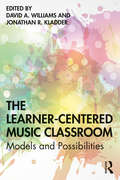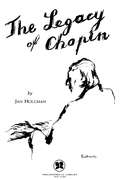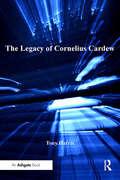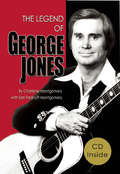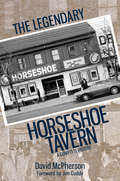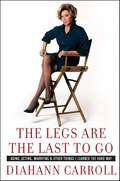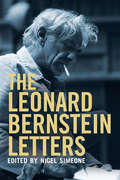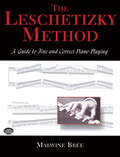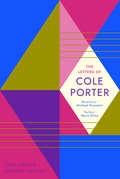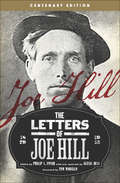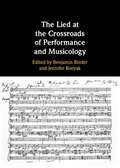- Table View
- List View
The Last Days (Peeps #2)
by Scott WesterfeldStrange things are happening: people going crazy in the streets, old friends disappearing, angels (or devils) clambering on the fire escapes of New York City. But for Pearl, Moz and Zahler, all that matters is their new band. As the city reels under a mysterious epidemic, the three combine their talents with a vampire lead signer and a drummer whose fractured mind can glimpse the coming darkness. Will their music stave off the end of the world? Or summon it? Set against the gritty apocalypse that began in Parasite Positive, THE LAST DAYS is about five teenagers who find themselves creating the soundtrack for the end of the world.
The Last Days of John Lennon
by James PattersonThe greatest true-crime story in music history, as only James Patterson can tell it. With the Beatles, John Lennon surpasses his youthful dreams, achieving a level of superstardom that defies classification. “We were the best bloody band there was,” he says. “There was nobody to touch us.” <P><P>Nobody except the original nowhere man, Mark David Chapman. Chapman once worshipped his idols from afar—but now harbors grudges against those, like Lennon, whom he feels betrayed him. He’s convinced Lennon has misled fans with his message of hope and peace. And Chapman’s not staying away any longer. By the summer of 1980, Lennon is recording new music for the first time in years, energized and ready for it to be “(Just Like) Starting Over.” He can’t wait to show the world what he will do. <P><P>Neither can Chapman, who quits his security job and boards a flight to New York, a handgun and bullets stowed in his luggage. The greatest true-crime story in music history, as only James Patterson can tell it. Enriched by exclusive interviews with Lennon’s friends and associates, including Paul McCartney, The Last Days of John Lennon is the thrilling true story of two men who changed history: One whose indelible songs enliven our world to this day—and the other who ended the beautiful music with five pulls of a trigger. <P><P><b>A New York Times Bestseller</b>
The Last Great Dream: How Bohemians Became Hippies and Created the Sixties
by Dennis McNally"McNally masterfully combines many disparate lineages of political, social, art, and pop history into one singular, sweeping portrait. The result is a stunning vision of a broad and powerful idealism that gripped the world for more than two decades."--Publishers Weekly (starred review) From the New York Times bestselling author of A Long Strange Trip and the publicist of the Grateful Dead, a riveting social history of everything that led up to the 1960s counterculture movement. Few cities represent the countercultural movement of the 1960s more than San Francisco. By that decade, the Haight-Ashbury neighborhood was home to self-branded &“freaks&” (dubbed &“hippies&” by the media) who created the world&’s first psychedelic neighborhood—an alchemical chamber for social transformation. They rejected a large part of the traditional American identity, passing over American exceptionalism, consumerism, misogyny, and militarism in favor of creativity, mind-body connection, peace, and love of all things.The Last Great Dream is a history of everything that led to the 1960s counterculture, when long-simmering resistance to American mainstream values birthed the hippie. It begins with the San Francisco Poetry Renaissance, peaks with the Human Be-in in Golden Gate Park, and ends with the Monterey Pop Festival that introduced Jimi Hendrix and Janis Joplin to the world. It tells of several micro-histories, including beat poetry, visual arts, underground publishing, electronic/contemporary compositional music, experimental theater, psychedelics, and more. Fascinating and definitive, The Last Great Dream is the ultimate guide to a generation-defining countercultural movement—an Underground 101 course for newcomers and aficionados alike.
The Last Opera: <I>The Rake’s Progress</I> in the Life of Stravinsky and Sung Drama (Russian Music Studies)
by Chandler CarterFrom the fall of 1947 through the summer of 1951 composer Igor Stravinsky and poet W. H. Auden collaborated on the opera The Rake’s Progress. At the time, their self-consciously conventional work seemed to appeal only to conservative audiences. Few perceived that Stravinsky and Auden were confronting the central crisis of the Modern age, for their story of a hapless eighteenth-century Everyman dramatizes the very limits of human will, a theme Auden insists underlies all opera. In The Last Opera, Chandler Carter weaves together three interlocking stories. The central and most detailed story explores the libretto and music of The Rake’s Progress. The second positions the opera as a focal point in Stravinsky's artistic journey and those who helped him realize it—his librettists, Auden and Chester Kallman; his protégé Robert Craft; and his compatriot, fellow composer, and close friend Nicolas Nabokov. By exploring the ominous cultural landscape in which these fascinating individuals lived and worked, the book captures a pivotal twenty-five-year span (from approximately 1945 to 1970) during which modernists like Stravinsky and Auden confronted a tectonic disruption to their artistic worldview. Ultimately, Carter reveals how these stories fit into a larger third narrative, the 400-year history of opera. This richly and lovingly contextualized study of The Rake’s Progress sheds new light on why, despite the hundreds of musical dramas and theater pieces that have been written since its premier in 1951, this work is still considered the "the last opera."
The Last Post: Music, Remembrance and the Great War
by Alwyn W. TurnerA history of the military bugle call, its use at the end of World War I on Armistice Day, and its effect in today’s culture.At eleven o’clock on the morning of the 11th November 1919 the entire British Empire came to a halt to remember the dead of the Great War. During that first two-minute silence all transport stayed still, all work ceased and millions stood motionless in the streets. The only human sound to be heard was the desolate weeping of those overcome by grief. Then the moment was brought to an end by the playing of the Last Post.A century on, that lone bugle call remains the most emotionally charged piece of music in public life. In an increasingly secular society, it is the closest thing we have to a sacred anthem. Yet along with the poppy, the Cenotaph and the tomb of the Unknown Warrior, its power is profoundly modern. It is a response to the trauma of war that could only have evolved in a democratic age.In this moving exploration of the Last Post’s history, Alwyn W. Turner considers the call’s humble origins and shows how its mournful simplicity reached beyond class, beyond religion, beyond patriotism to speak directly to peoples around the world. Along the way he contemplates the relationship between history and remembrance, and seeks out the legacy of the First World War in today’s culture.
The Last Seat in the House: The Story of Hanley Sound (American Made Music Series)
by John KaneKnown as the "Father of Festival Sound," Bill Hanley (b. 1937) made his indelible mark as a sound engineer at the 1969 Woodstock Music and Arts Fair. Hanley is credited with creating the sound of Woodstock, which literally made the massive festival possible. Stories of his on-the-fly solutions resonate as legend among festivalgoers, music lovers, and sound engineers. Since the 1950s his passion for audio has changed the way audiences listen to and technicians approach quality live concert sound. John Kane examines Hanley’s echoing impact on the entire field of sound engineering, that crucial but often-overlooked carrier wave of contemporary music. Hanley’s innovations founded the sound reinforcement industry and launched a new area of technology, rich with clarity and intelligibility. By the early seventies the post-Woodstock festival mass gathering movement collapsed. The music industry shifted, and new sound companies surfaced. After huge financial losses and facing stiff competition, Hanley lost his hold on a business he helped create. By studying both his history during the festivals and his independent business ventures, Kane seeks to present an honest portrayal of Hanley and his acumen and contributions. Since 2011, Kane conducted extensive research, including over one hundred interviews with music legends from the production and performance side of the industry. These carefully selected respondents witnessed Hanley’s expertise at various events and venues like Lyndon B. Johnson’s second inauguration, the Newport Folk/Jazz Festivals, the Beatles' final tour of 1966, the Fillmore East, Madison Square Garden, and more. The Last Seat in the House will intrigue and inform anyone who cares about the modern music industry.
The Last Sultan
by Robert GreenfieldThe Last Sultan is the definitive biography of a man who changed popular culture throughout the world. As the founder and head of Atlantic Records, Ahmet Ertegun signed and/or recorded many of the greatest musical artists of all time, among them Ruth Brown; Big Joe Turner; Ray Charles; Bobby Darin; Sonny and Cher; Eric Clapton; Buffalo Springfield; Crosby, Stills, Nash & Young; Led Zeppelin; the Rolling Stones; Bette Midler; and Kid Rock. Working alongside his older brother, Nesuhi, one of the preeminent jazz producers of all time, and the legendary Jerry Wexler, who produced great soul artists like Wilson Pickett, Solomon Burke, and Aretha Franklin, Ertegun transformed Atlantic Records from a small independent record label into a hugely profitable multinational corporation. In successive generations, he also served as a mentor to record-business tyros like Phil Spector, David Geffen, and Lyor Cohen. Brilliant, cultured, and irreverent, Ertegun was as renowned for his incredible sense of personal style and nonstop A-list social life as his work in the studio. Born into great privilege as the son of a high-ranking Turkish diplomat during the last days of the Ottoman Empire, Ertegun spent his life bringing the black-roots music he loved to the world. A larger-than-life figure, always hip, Ertegun lived in the grand manner but was never happier than when he found himself in some down-and-out joint listening to music late at night. Blessed with impeccable taste and brilliant business acumen, he brought rock 'n' roll into the mainstream while creating the music that became the sound track for the lives of multiple generations. With supporting characters like Steve Ross, Henry Kissinger, Mick Jagger, Keith Richards, Jann Wenner, and a host of others, The Last Sultan is the fascinating story of a man who always lived by his own rules.
The Last Waltz: The Strauss Dynasty and Vienna
by John SuchetCaptured in a beautiful package, including more than fifty color photographs, The Last Waltz tells the intriguing story of of the Viennese Strauss family known for producing some of the best known, best loved music of the nineteenth century. Johann and Josef Strauss, the Waltz Kings, composed hundreds of instantly recognizable and enduringmelodies, including The Blue Danube Waltz, Tales from the Vienna Woods, Voices of Spring and The Radetzky March. Their iconic music has been featured on the scores of nearly a thousand films.Yet despite their success, this was a family riven with tension, feuds and jealousy, living in a country that was undergoing seismic upheaval. Through the personal and political chaos, the Strauss family continued to compose music to which the Viennese - anxious to forget their troubles - could dance and drank champagne, even as their country hurtled towards oblivion at the hands of the First World War. Classical music expert and radio host John Suchet skillfully portrays this gripping story, capturing the family dramas, the tensions, triumphs and disasters against the turbulent backdrop of Austria in the nineteenth century, from revolution to regicide.
The Late Starters Orchestra
by Ari L. GoldmanIn a cluttered room in an abandoned coat factory in lower Manhattan, a group of musicians comes together each week to make music. Some are old, some are young, all have come late to music or come back to it after a long absence. This is the Late Starters Orchestra--the bona fide amateur string orchestra where Ari Goldman pursues his lifelong dream of playing the cello. Goldman hadn’t seriously picked up his cello in twenty-five years, but the Late Starters (its motto, If you think you can play, you can) seemed just the right orchestra for this music lover whose busy life had always gotten in the way of its pursuit.In The Late Starters Orchestra, Goldman takes us along to LSO rehearsals and lets us sit in on his son’s Suzuki lessons, where we find out that children do indeed learn differently from adults. He explores history’s greatest cellists and also attempts to understand what motivates his fellow late starters, amateurs all, whose quest is for joy, not greatness. And when Goldman commits to playing at his upcoming birthday party we wonder with him whether he’ll be good enough to perform in public. To the rescue comes the ghost of Goldman’s first cello teacher, the wise and eccentric Mr. J, who continues to inspire and guide him--about music and more--through this well-tuned journey. With enchanting illustrations by Eric Hanson, The Late Starters Orchestra is about teachers and students, fathers and sons, courage and creativity, individual perseverance and the power of community. And Ari Goldman has a message for anyone who has ever had a dream deferred: it’s never too late to find happiness on one’s own terms.
The Later Diaries of Ned Rorem, 1961–1972: 1961-1972
by Ned RoremThe esteemed American composer and unabashed diarist Ned Rorem provides a fascinating, brazenly intimate first-person account of his life and career during one of the most extraordinary decades of the twentieth century Ned Rorem is often considered an American treasure, one of the greatest contemporary composers in the US. In 1966, he revealed another side of his remarkable talent when The Paris Diary was published, and a year later, The New York Diary, both to wide critical acclaim. In The Later Diaries,Rorem continues to explore his world and his music in intimate journal form, covering the years 1961 to 1972, one of his most artistically productive decades. The Ned Rorem revealed in The Later Diaries is somewhat more mature and worldly than the young artist of the earlier works, but no less candid or daring, as he reflects on his astonishing life, loves, friendships, and rivalries during an epoch of staggering, sometimes volatile change. Writing with intelligence, insight, and honesty, he recalls time spent with some of the most famous, and infamous, artists of the era—Philip Roth, Christopher Isherwood, Tallulah Bankhead, and Edward Albee, among others—openly exploring his sexuality and his art while offering fascinating, sometimes blistering, views on the art of his contemporaries.
The Latin Bass Book
by Sher Music Oscar Stagnaro Chuck SherThe only comprehensive book ever published on how to play bass in authentic Afro-Cuban, Brazilian, Caribbean and various South American styles. Over 250 pages of exact transcriptions of every note Oscar plays on the 3 accompanying CDs. Endorsed by Down Beat magazine, Latin Beat magazine, Benny Rietveld, etc.
The Learner-Centered Music Classroom: Models and Possibilities
by David A. Williams Jonathan R. KladderThe Learner-Centered Music Classroom: Models and Possibilities is a resource for practicing music teachers, providing them with practical ideas and lesson plans for implementing learner-centered pedagogical concepts into their music classrooms. The purpose of this book is to propose a variety of learner-centered models for music teaching and learning through the use of a variety of autoethnographic viewpoints. Nine contributors provide working and concrete examples of learner-centered models from their classrooms. Offering lesson plan ideas in each of these areas, the contributors provide practical approaches for implementation of learner-centered approaches in music instruction across a variety of landscapes. Learner-centered teaching provides an approach to music education that encourages social, interactive, culturally responsive, creative, peer-based, open-formed, facilitated and democratic learning. Chapter 1 defines the what, why, and perceived benefits of learner-centered approaches in music teaching and learning contexts Chapters 2-10 will include example lesson plans, rubrics, etc. as models for teachers. The contributors to this book suggest that learner-centered approaches, when embedded into the culture and curricular framework of a music classroom, offer exciting approaches for teaching music in ways that are culturally and educationally appropriate in contemporary education.
The Learner-Centered Music Classroom: Models and Possibilities
by David A. Williams Jonathan R. KladderThe Learner-Centered Music Classroom: Models and Possibilities is a resource for practicing music teachers, providing them with practical ideas and lesson plans for implementing learner-centered pedagogical concepts into their music classrooms. The purpose of this book is to propose a variety of learner-centered models for music teaching and learning through the use of a variety of autoethnographic viewpoints. Nine contributors provide working and concrete examples of learner-centered models from their classrooms. Offering lesson plan ideas in each of these areas, the contributors provide practical approaches for implementation of learner-centered approaches in music instruction across a variety of landscapes.Learner-centered teaching provides an approach to music education that encourages social, interactive, culturally responsive, creative, peer-based, open-formed, facilitated and democratic learning. Chapter 1 defines the what, why, and perceived benefits of learner-centered approaches in music teaching and learning contexts Chapters 2-10 will include example lesson plans, rubrics, etc. as models for teachers. The contributors to this book suggest that learner-centered approaches, when embedded into the culture and curricular framework of a music classroom, offer exciting approaches for teaching music in ways that are culturally and educationally appropriate in contemporary education.
The Legacy of Chopin
by Jan HolcmanJan Holcman's Legacy of Chopin brings together Chopin's views on music, including pianism, composition, teaching, music criticism, and more. With extensive references and footnotes from the author, readers can gain unparalleled knowledge into the famous composer's theories, practices, and philosophies.
The Legacy of Chopin
by Jan HolcmanA fascinating survey of Chopin&’s views on music, from composition theory to his philosophy of teaching, including explanatory notes from the author. The Legacy of Chopin is a comprehensive study of the great composer&’s views on music—including pianism, composition, pedagogy, music criticism, and more. Drawing on extensive research from a wide range of sources, Jan Holcman provides essential historical and musicological context for Chopin&’s references and concepts, making his more esoteric ideas accessible to the general reader. An author and musicologist, Holcman shares his deep knowledge of Chopin&’s life and oeuvre in this enlightening exploration of his theories, practices, and philosophies.
The Legacy of Cornelius Cardew
by Tony HarrisCornelius Cardew is an enigma. Depending on which sources one consults he is either an influential and iconic figure of British musical culture or a marginal curiosity, a footnote to a misguided musical phenomenon. He is both praised for his uncompromising commitment to world-changing politics, and mocked for being blindly caught up in a maelstrom of naïve political folly. His works are both widely lauded as landmark achievements of the British avant-garde and ridiculed as an archaic and irrelevant footnote to the established musical culture. Even the events of his death are shrouded in mystery and lack a sense of closure. As long ago as 1967, Morton Feldman cited Cardew as an influential figure, central to the future of modern music-making. The extent to which Cardew has been a central figure and a force for new ideas in music forms the backbone to this book. Harris demonstrates that Cardew was an original thinker, a charismatic leader, an able facilitator, and a committed activist. He argues that Cardew exerted considerable influence on numerous individuals and groups, but also demonstrates how the composer's significance has been variously underestimated, undermined and misrepresented. Cardew's diverse body of work and activity is here given coherence by its sharing in the values and principles that underpinned the composer's world view. The apparently disparate and contradictory episodes of Cardew's career are shown to be fused by a cohesive 'Cardew aesthetic' that permeates the man, his politics and his music.
The Legacy of Johann Strauss
by Zoë Alexis LangThe Legacy of Johann Strauss examines constructions of Austrian identity through the reception of Johann Strauss Jr. 's waltzes in the twentieth century. Zoe Lang argues that the music of Strauss Jr. remained popular because it continued to be revitalized by Austrians seeking to define their culture. Press coverage from the 1925 centennial celebration of Strauss Jr. 's birth celebrations in Vienna shows how he was reinvented for the new, post-Habsburg nation. The book also includes a discussion of the origins of the Vienna Philharmonic's New Year's Concert and considers how Strauss Jr. was appropriated as a National Socialist icon in the 1930s and 1940s. The Strauss family's Jewish ancestry is discussed, along with the infamous forgery of paperwork about their lineage during the 1940s. There is also a case study of Strauss Jr. 's Emperor Waltz, considering its variegated usage in concerts and films from 1925-1953.
The Legend of George Jones
by Peanutt Montgomery Charlene MontgomeryGeorge Jones lived a storied life, but his career was not without controversies. This book reveals fascinating, intimate details about the life of George Jones that have never before been published. Charlene and Peanutt Montgomery, who were George's closest friends and confidants over a thirty-year period and the songwriters for the vast majority of the songs that George recorded, are the authors of this highly entertaining book. Their strong bonds with and admiration for George come shining through, even when writing about the less-than-flattering incidents and times that make up part of the story. This book contains a CD album of 12 songs written by George Jones and Peanutt Montgomery, including the never before released title song, The Legend of George Jones. Peanutt wrote 77 songs for George Jones over more than 30 years, all of which were top 40 songs, with some reaching #1 hit status. A variety of well-known country music artists sing the songs on the CD album. The album becomes a bonus treat for the readers.
The Legendary Horseshoe Tavern: A Complete History
by David Mcpherson Jim CuddyA complete history of Toronto’s legendary Horseshoe Tavern, “the Birthplace of Canadian Rock,” to coincide with its seventieth anniversary. Like the Queen Street strip that has been its home for seven decades, the Horseshoe Tavern continues to evolve. It remains as relevant today as it did when Jack Starr founded the country music club on the site of a former blacksmith shop. From country and rockabilly to rock ‘n’ roll, punk, alt/country, and back to roots music, the venerable live music venue has evolved with the times and trends — always keeping pace with the music. Over its long history, the Horseshoe has seen a flood of talent pass through. From Willie Nelson to Loretta Lynn, Stompin’ Tom Connors to The Band, and Bryan Adams to the Tragically Hip, the Horseshoe has attracted premier acts from all eras of music. In The Legendary Horseshoe Tavern, David McPherson captures the turbulent life of the bar, and of Canadian rock.
The Legs Are the Last to Go: Aging, Acting, Marrying, & Other Things I Learned the Hard Way
by Diahann CarrollIt's conventional wisdom that Hollywood has no use for a woman over forty. So it's a good thing that Diahann Carroll—whose winning, sometimes controversial career breached racial barriers—is anything but conventional.Here she shares her life story with an admirable candidness of someone who has seen and done it all. With wisdom that only aging gracefully can bestow, she talks frankly about her four marriages as well as the other significant relationships in her life, including her courtship with Sidney Poitier; racial politics in Hollywood and on Broadway; and the personal cost, particularly to her family, of being a pioneer. Carroll's storied history, blunt views, and notorious wit will be sure to entertain and inform.
The Leonard Bernstein Letters
by Leonard Bernstein&“With their intellectual brilliance, humor and wonderful eye for detail, Leonard Bernstein&’s letters blow all biographies out of the water.&”—The Economist (2013 Book of the Year) Leonard Bernstein was a charismatic and versatile musician—a brilliant conductor who attained international superstar status, and a gifted composer of Broadway musicals (West Side Story), symphonies (Age of Anxiety), choral works (Chichester Psalms), film scores (On the Waterfront), and much more. Bernstein was also an enthusiastic letter writer, and this book is the first to present a wide-ranging selection of his correspondence. The letters have been selected for the insights they offer into the passions of his life—musical and personal—and the extravagant scope of his musical and extra-musical activities. Bernstein&’s letters tell much about this complex man, his collaborators, his mentors, and others close to him. His galaxy of correspondents encompassed, among others, Aaron Copland, Stephen Sondheim, Jerome Robbins, Thornton Wilder, Boris Pasternak, Bette Davis, Adolph Green, Jacqueline Kennedy Onassis, and family members including his wife Felicia and his sister Shirley. The majority of these letters have never been published before. They have been carefully chosen to demonstrate the breadth of Bernstein&’s musical interests, his constant struggle to find the time to compose, his turbulent and complex sexuality, his political activities, and his endless capacity for hard work. Beyond all this, these writings provide a glimpse of the man behind the legends: his humanity, warmth, volatility, intellectual brilliance, wonderful eye for descriptive detail, and humor. &“The correspondence from and to the remarkable conductor is full of pleasure and insights.&”—The New York Times Book Review (Editors&’ Choice) &“Exhaustive, thrilling [and] indispensable.&”—USA Today (starred review)
The Leschetizky Method: A Guide to Fine and Correct Piano Playing (Dover Books on Music)
by Malwine BréeBorn in Poland in 1830, Theodor Leschetizky was a pianist, teacher, and composer. Although he toured widely as both a player and conductor, and composed two operas and a number of piano pieces, it was as a teacher that he achieved his greatest renown. A pupil himself of the great Carl Czerny, Leschetizky went on to instruct an entire generation of world-class pianists, including Paderewski, Schnabel, Moiseiwitsch, Brailowsky, and many others.In this legendary, hard-to-find book, his pupil and assistant Malwine Brée recorded the principles and techniques of the "Leschetizky Method" of piano instruction. Approved by Leschetizky himself, the clear, easy-to-follow text, profusely illustrated with music examples and photographs of hand positions (Leschetizky's own hands), covers every aspect of piano technique: finger exercises, scales, octaves, chords, arpeggios, the glissando, embellishments, dynamics, the pedal, and many other topics. Also included here is a fascinating article, "Practical Hints on Piano Study" by Ignace J. Paderewski, along with other articles on hand and finger exercises, other piano methods, and more. Any student and teacher of piano will want to have this classic instruction manual, difficult to locate in the past, but now available in this attractive, inexpensive edition.
The Letters of Cole Porter
by Cole PorterThe first comprehensive collection of the letters of one of the most successful American songwriters of the twentieth century From Anything Goes to Kiss Me, Kate, Cole Porter left a lasting legacy of iconic songs including "You're the Top," "Love For Sale," and "Night and Day." Yet, alongside his professional success, Porter led an eclectic personal life which featured exuberant parties, scandalous affairs, and chronic health problems. This extensive collection of letters (most of which are published here for the first time) dates from the first decade of the twentieth century to the early 1960s and features correspondence with stars such as Irving Berlin, Ethel Merman, and Orson Welles, as well as his friends and lovers. Cliff Eisen and Dominic McHugh complement these letters with lively commentaries that draw together the loose threads of Porter&’s life and highlight the distinctions between Porter&’s public and private existence. This book reveals surprising insights into his attitudes toward Hollywood and Broadway, and toward money, love, and dazzling success.
The Letters of Joe Hill: Centenary Edition
by Joe HillThe legendary songwriter and labor rights activist reveals his personal struggles and political philosophy in this collection of letters.As a proud member of the Industrial Workers of the World, Joe Hill dedicated his life to the union cause. The original bard of the working class, he spread a message of solidarity and struggle through unforgettable, bitingly satirical songs. But after a suspicious arrest and controversial trial, Hill was convicted of murder in 1914. A year later, he was put to death by the capitalist state.In this collection of letters, many of which were written from prison in Salt Lake City, readers get to know the man behind the legendary songs. Hill corresponds with friends and fellow workers, discussing his case, his life, his music, and cheering on the Wobblies even as he faces death.“Joe Hill's influence is everywhere. Without Joe Hill, there's no Woody Guthrie, no Dylan, no Springsteen, no Clash, no Public Enemy, no Minor Threat, no System of a Down, no Rage Against the Machine.” —Tom Morello, from the foreword
The Lied at the Crossroads of Performance and Musicology
by Jennifer Ronyak Benjamin BinderThere seems to be an essential relationship between the performance and the scholarship of the German Lied. Yet the process by which scholarly inquiry and performative practices mutually benefit one another can appear mysterious and undefined, in part because any dialogue between the two invariably unfolds in relatively informal environments – such as the rehearsal studio, seminar room or conference workshop. Contributions from leading musicologists and prominent Lied performers here build on and deepen these interactions to reconsider topics including Werktreue aesthetics and concert practices; the authority of the composer versus the performer; the value of lesser-known, incomplete, or compositionally modified songs; and the traditions, habits and prejudices of song recitalists regarding issues like transposition, programming and dramatic modes of presentation. The book as a whole reveals the reciprocal relevance of Lied musicology and Lied performance, thereby opening doors to fresh and exciting modes of interpretative artistry and intellectual discovery.
